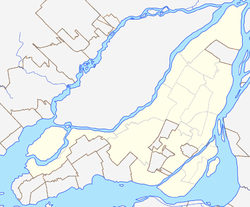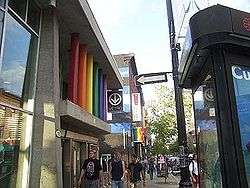Gay Village, Montreal
| Gay Village Le Village gai | |
|---|---|
| Neighbourhood | |
|
A partial view of Montreal's Gay Village, with Beaudry Metro station to the left. | |
 Gay Village Location of the Gay Village in Montreal | |
| Coordinates: 45°31′08″N 73°33′21″W / 45.518825°N 73.555798°WCoordinates: 45°31′08″N 73°33′21″W / 45.518825°N 73.555798°W | |
| Country | Canada |
| Province | Quebec |
| City | Montreal |
| Borough | Ville-Marie |
Montreal's Gay Village (The Village, French, Le Village gai or simply Le Village) is located on Saint Catherine Street East, centred on the Beaudry Metro station, and on Amherst Street in the Ville-Marie borough of the city. The Village runs approximately from St-Hubert Street to De Lorimier Street on Saint Catherine Street, and between Sherbrooke Street and René Lévesque Boulevard on Amherst Street, a distance of nearly two kilometres, making it the largest in North America in terms of scope of the complete area.
Formerly a poor working-class neighbourhood, part of the Centre-Sud area of the city, the area was occupied by the gay and lesbian community after the huge expulsion of many gay businesses from an area closer to Saint Lawrence Boulevard (or "The Main" as the locals call it). The area has been considerably gentrified, due in part to recent investment from the various levels of all governments.
Indeed, despite repression as late as the early 1990s, recent government support of "Le Village" has been significant. All three levels of government are aggressively promoting the Village and gay life in Montreal as a tourist attraction. In recognition of the Village's importance to the city, Montreal's Ville-Marie borough that includes the Village recently hung a rainbow flag in its council chambers, and redecorated the entrance to the Beaudry Metro station found in the heart of the Gay Village with rainbow pillars. The Village is specifically marked on official city maps as "Le Village".
History
The first recorded gay establishment in North America was Montrealer Moise Tellier’s apple and cake shop on Craig Street (now Saint Antoine Street) in 1869.
There were generally two concentrations of establishments where gays were welcome, or that, by the 1970s, became openly gay businesses. This mirrored Montreal's more language-segregated culture. These were the Montreal West End (mainly anglophone) and The Main (mixed, but mainly francophone):
Montreal West End
The West End of Montreal's downtown was centered in the western end of the downtown area of the city, with bars on Stanley Street and Drummond Street, and with Shaughnessy Village west of Guy Street (officially rue Guy) as its residential neighbourhood. In fact, this was seen as the mostly anglophone gay village.[1] By the 1950s, Dominion Square (now Dorchester Square) was seen as an area where men could meet and cruise and the centrally located "Dominion Square Tavern" was known as a place where gays could meet (it still exists today but has lost its gay clientele). As is traditional, until the 1980s, gay life was centered on bars and taverns, and some restaurants, which tolerated a gay clientele. By the late 1960s and early 1970s, many gay-owned or gay-open businesses existed, and it became the city's main gay concentration, though it was still relatively marginal and kept discreet. The businesses consisted mainly of clubs, where men could dance.
The Main
The Main, the strip of businesses on Saint-Laurent Boulevard, and east along Saint Catherine Street East, an area also known as "Le Red Light", since the businesses catered to a marginal clientele. The east had a more francophone clientele. Here, the businesses consisted mainly of taverns, often featuring drag shows.
Closure of gay businesses in the past
The businesses in these two areas (West End and Main) came under regular repression, especially just before Montreal's Expo 67 World's Fair and the Olympic Games in 1976. "Sauna Aquarius" was raided in February 1975 followed by six gay and lesbian bars in October 1975, "Les Bains Clubs" (23 January 1976), "Sauna Cristal" (11 February). Because of the increased police repression, the Comité homosexuel anti-repression (the Gay Coalition Against Repression) was formed and hosted what was then the largest gay demonstration in Canada on 19 July 1976. In mid March 1987, "Sauna Neptune", "Taureau d'Or", "Studio 1", "Club Stork", "le Jilly's" and many others were closed and a number of proprietors had to close after dubious accusations. A number of proprietors and clients were arrested.[2]
Development of Gay Village
Originally, there were only a handful of establishments located in what is now the Village gai. In the early 1980s, some bars opened along Saint-Catherine Street East, between Berri Street and Papineau Avenue, in Montreal's Centre-Sud area. Eventually, a new generation of gays also moved into the neighbourhood, both anglophone and francophone. Many came from other parts of Quebec. This was encouraged by the creation of a "Quartier Latin" (in English Latin Quarter) dominated by the new campus of the Université du Québec à Montréal.
The phrase "Le Village de l'Est" (the Eastern Village) was coined by one of the original bar owners from then-popular bar/club called K.O.X. in an advertisement. After living in New York City, it was his intention to create a strong vibrant gay community similar to the East Village in New York. The phrase was used as a way to refer to this new community, referring to its eastern geographical location from downtown, as opposed to the traditional west end. Eventually the name shortened to simply "Le Village" by the gay community itself. The success was solidified by the fact that it became both a gay residential and commercial district. But its success reflected the near disappearance of gay businesses from the west of downtown.
By the 1990s, "The Village" had already started its expansion on Amherst Street, with the departure of many antique shops, more gay owned and operated businesses were emerging. At the same time, it had become well-established, gaining political recognition and acceptance by all LGBT persons as well as heterosexuals. It has continuously thrived, gaining popularity, the area has been beautified, and housing has been renovated. Almost all gay businesses in Montréal are now situated in this area.
Although many gays reside and are very present in other parts of Montreal, the Gay Village remains the heart, and service centre for, Montreal's LGBT community. Each year, Sainte-Catherine Street - heart of the Village, becomes a pedestrian street from May to September.[3] The wide outdoor area offers many terraces, welcoming tourists with major events such as Le Festival International de Montréal en Arts,[4] Fierté Montreal Pride [5] and Divers-Cité's Festival.[6]
See also
- List of gay villages
- Fierté Montréal - The community event today.
- Divers/Cité - Years active from 1993 to 2014.
- OutGames
- Gay Village, Toronto
- Gay Village, Vancouver
Notes
- ↑ Andrea Zanin. "The Village Comes Out: A Quick History". Go-Montreal.com. Retrieved 2008-03-28.
- ↑ Fierté Montréal site History page
- ↑ Aires Libres (Sainte-Catherine Street for pedestrians
- ↑ Festival International de Montréal en Arts
- ↑ Fierté Montreal Pride
- ↑ Montreal's Divers-Cité Festival
References
- Official census of the Gay Village. (French)
